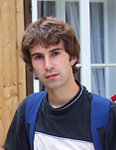|
2014
Fernandez-Götz, M. A.: Identity and Power: The transformation of Iron Age societies in northeast Gaul. Amsterdam Archaeological Studies 21. Amsterdam University Press, Amsterdam.
2014
Fernandez-Götz, M. A.: De la familia a la etnia: Protohistoria de la Galia Oriental. Bibliotheca Archaeologica Hispana. Real Academia de la Historia, Madrid.
2014
Fernandez-Götz, M. A.: Villages and Cities in Early Europe. Antiquity 88, 339: 304-307.
2013
Fernandez-Götz, M. A. and Krausse, D.: Rethinking Early Iron Age Urbanisation in Central Europe: The Heuneburg Site and its Archaeological Environment. Antiquity 87, 336: 473-487.
2013
Fernandez-Götz, M. A.: Revisiting Iron Age Ethnicity. European Journal of Archaeology 16(1): 116-136.
2013
Fernandez-Götz, M. A.: Ethnicité, politique et échelles d’intégration: réflexions sur les «pagi » gaulois avant la Conquête. Études Celtiques 39: 7-29.
2013
Fernandez-Götz, M. A.: Una nueva mirada sobre los oppida de la Europa Templada. Complutum 24(1): 131-150.
2013
Krausse, D.; Fernandez-Götz, M. A.; Steffen, C., Wahl, J. and Otte-Scheschkewitz, P.: Vom Burgberg zur Donau: Neue Untersuchungen zur Heuneburg (2008-2012). Archäologisches Korrespondenzblatt 43(2): 195-213.
2012
Ade,D.; Fernandez-Götz, M. A.; Rademacher, L.; Stegmaier, G. and Willmy, A.: Der Heidengraben – Ein keltisches Oppidum auf der Schwäbischen Alb. Konrad Theiss Verlag, Stuttgart.
2012
Fernandez-Götz, M. A.: Die Rolle der Heiligtümer bei der Konstruktion kollektiver Identitäten: das Beispiel der treverischen Oppida. Archäologisches Korrespondenzblatt 42(4): 509-524.
2012
Fernandez-Götz, M. A.: Identität und Macht: das Mittlerhein- und Moselgebiet von der frühen Eisenzeit bis zur Romanisierung (600 v. Chr. – 70 n. Chr.). Archäologische Informationen 35: 343-350.
2012
Fernandez-Götz, M. A. and Krausse, D.: Heuneburg. First city north of the Alps. Current World Archaeology 55: 28-34.
2012
Fernandez-Götz, M. A. and Krausse, D.: Die Heuneburg. Neue Forschungen zur Entwicklung einer späthallstattzeitlichen Stadt. In: Die Welt der Kelten. Zentren der Macht – Kostbarkeiten der Kunst. Jan Thorbecke Verlag, Ostfildern: 116-123.
2012
Fernandez-Götz, M. A. and Ruiz Zapatero, G.: Die «Kelten» im Spannungsfeld von wissenschaftlicher Forschung und populärer Rezeption. In R. Karl, J. Leskovar and S. Moser (eds.), Die erfundenen Kelten – Mythologie eines Begriffes und seine Verwendung in Archäologie, Tourismus und Esoterik. Oberösterreichisches Landesmuseum, Linz: 81-93 .
2011
Fernandez-Götz, M. A.: Cultos, ferias y asambleas: los santuarios protohistóricos del Rin
Medio-Mosela como espacios de agregación. Palaeohispánica 11: 127-154.
2011
Fernandez-Götz, M. A.: Niveles sociopolíticos y órganos de gobierno en la Galia de finales de la Protohistoria. Habis 42: 7-26.4.
2011
Fernandez-Götz, M. A. and Ruiz Zapatero, G.: Hacia una Arqueología de la etnicidad. Trabajos de Prehistoria68 (2): 219-236.
2011
Fernandez-Götz, M. A. and García Fernández, F. J.: Die ethnische Fragestellung in der spanischen Archäologie: eine wissenschaftsgeschichtliche Perspektive. Ethnographisch-Archäologische Zeitschrift (EAZ) 52(1): 104-118.
2009
Fernandez-Götz, M. A.: Ethnische Interpretationen in der Eisenzeitarchäologie: Grenzen und Möglichkeiten. In G. Uelsberg and M. Schmauder (eds.), Kelten am Rhein. Akten des dreizehnten Internationalen Keltologiekongresses. Beihefte Bonner Jahrbücher 58/1, Bonn: 13-23.
2008
Fernandez-Götz, M. A.: La construcción arqueológica de la etnicidad. Serie Keltia 42. Editorial Toxosoutos, Noia (A Coruña).
|


